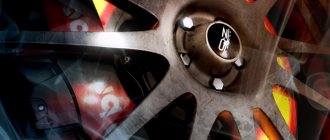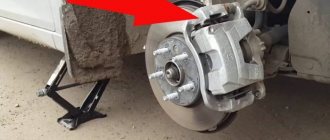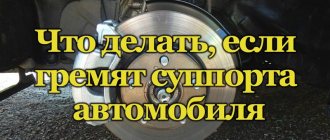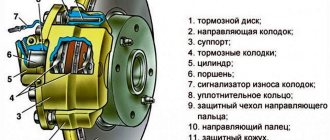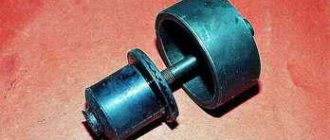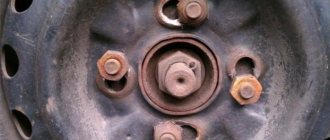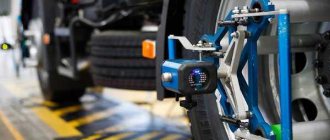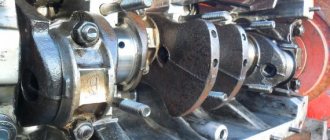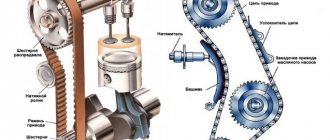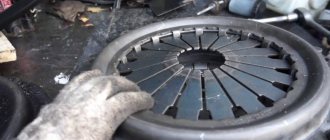The creaking of silent blocks, like any noise in the suspension, is always unpleasant because it means the need for immediate replacement. And if a creak appears after replacing the silent blocks with new ones, this is even more annoying, because such a problem should not exist by default.
If you want to know when silent blocks creak, why this happens and what to do about it, because there are several methods at once, then read the article to the end.
If the silent blocks are not new, then most often a creaking indicates their wear and need to be replaced. Neither lubricant nor other manipulations will get rid of squeaking for a long time. But when a squeak appears after replacement, the reasons may be different and it will most likely be possible to remove it.
The table below briefly summarizes all the causes of silent blocks creaking and possible methods for eliminating them. Moreover, these reasons are universal for all types of parts, regardless of their type and installation location. All this is described in more detail below.
| Causes | Solutions | |
| №1 | №2 | |
| Wear of old silent blocks | Replacement | Give lubricant |
| Insufficient fastening torque | Tighten fastenings | × |
| Incorrect installation | Reinstall correctly | If damaged, replace |
| Lack of lubrication | Add lubricant (different types) | Use WD-40 (short term effect) |
| Grinding in of new silent blocks | Will pass through 200-500 kilometers | × |
| Design Features | Find an analogue from another model | × |
| Poor quality | Replace with high-quality analogues or original | × |
Purpose
The silent block is a cylinder-shaped part. Consists of a metal outer part (clip), a metal sleeve and a soft filler between the clip and the sleeve. The filler is rubber, polyurethane or polymer. The metal and rubber parts are secured by gluing or vulcanization. The following types of silent blocks differ:
- Torsion. Equipped with a cavity for load absorption. Installed with strict adherence to the position;
- Lever. They are a rubber cylinder with metal eyes. Used for front suspensions;
- Ball or floating. The most common type of silent blocks. Used to connect wheel struts to suspension arms.
These are the main types of silent blocks. Products are constantly being improved. The main changes are the material of the soft filler and the holder body.
The main purpose of silent blocks is to absorb radial, angular and axial loads. They also help absorb a significant part of the vibration.
What is a silent block?
A silent block is a hinge consisting of two metal bushings with a rubber or polyurethane insert. Serves to fasten parts together (suspension, engine, transmission, etc.).
It replaced metal ones in the middle of the last century. Thanks to a rubber or polyurethane insert, it dampens vibrations of parts among themselves, taking on the main load of the components.
Depending on the filling of the bushings, silent blocks can be rubber or polyurethane .
- Rubber
They are used by most car owners because they are cheaper and have proven themselves on domestic and foreign cars. Present even on 30-ton Volvo trucks. The downside is that they are less durable (if a resource of 50-200 thousand can be considered as such for such consumables). Also sometimes found from low-quality rubber.
- Polyurethane
Mainly used on sports cars. They are more expensive, have a longer service life, improve handling, but also increase suspension stiffness.
Minuses:
- Since most fasteners that use blocks are subject to torsional loads, polyurethane is inappropriate and even dangerous for parts. It is effective on sliding/tilting (bushings of stabilizers, shock absorbers and hinges of some Toyota and Mitsubishi models).
Rubber perfectly handles the torsional load without jeopardizing the suspension arms.
- In addition, polyurethane increases the stiffness of the suspension, which is critical on our roads (it will not cause concussions).
- The third disadvantage: the resource declared by marketers to be “5 times greater” is in fact the same as that of rubber ones - in inexpensive models. In the case where it is larger, the price is several times more expensive, which is equivalent at best. Not to mention how many problems are described in the cold.
Checking the silents - do they really creak?
While operating the car, owners are faced with the problem of silent blocks squeaking. This is a common phenomenon and can occur in both new and used cars. When a squeak appears, you need to make sure that the squeak comes from the silent parts. To do this you need:
- Place the car on an overpass or “pit”;
- Lubricate one block at a time;
- Rock the car. The rocking will simulate movement over uneven surfaces.
If the creaking does not disappear, you need to continue alternate lubrication and rocking. As soon as the squeak disappears, we can conclude that the damaged part has been accurately identified.
When a squeak appears, it is worth considering that it can occur after:
- After replacing with new ones. The parts just haven't gotten used to it yet;
- Changes in air temperature. Rubber hardens in the cold;
- If the part has cavities, then moisture or dirt could get into them.
It is worth carrying out a full diagnosis of the suspension and determining the exact cause of the squeak. Below is a description of the most common reasons.
Results
Replacing a worn silent block is not only the elimination of extraneous debilitating squeaks, but also a prerequisite for the fact that something is wrong with the car’s chassis. Wear causes tires to wear improperly, which can lead to premature wear even with ideal driving. Controllability on any part of the highway deteriorates and the risk of causing an emergency increases.
If you have an Aveo, look for analogues from Mondeo. Although General Motors has already officially presented a line of silent blocks of a new type, without holes, so it makes sense to look for original spare parts.
Causes of squeaking
Skip and excess noise in the car is a kind of warning about a malfunction. The creaking of silent blocks indicates the beginning of wear of the suspension elements. Creaking may be accompanied by poor controllability and loss of dynamics. Next, we will describe the main causes of squeaking.
Wear
The working period of silents varies from 10 to 15 thousand kilometers. It is worth taking into account your driving style and the quality of the surface. In order to check these parts, it is necessary to drive the car onto an overpass and visually inspect the suspension. Indicates wear:
- Partial detachment of rubber from metal;
- Gap;
- Displacement of the metal part;
- Hardening of rubber;
- Wear at the connection with the metal bushing.
All these faults will require a complete replacement of the part. If it is not possible to visually determine the malfunction, you must manually loosen the connection or ask an assistant to rock the machine. This will help you quickly identify a worn part. Silents with cavities are characterized by squeaking if the cavities are clogged with dirt. It is worth cleaning and lubricating the cavities.
Weak puff
Weak tension in the silent mounting may occur due to natural causes (vibration) or due to a disruption in the process of replacing new blocks. To check you need:
- Place the car on the overpass;
- Ask an assistant to rock the car;
- Visually inspect all fasteners.
Very often the creaking is accompanied by shocks and vibrations. Loose fasteners must be tightened. This is done only if the car is placed on a level surface. During the tightening process, you can rock the machine. This way the block will fit exactly into place. Tightening on a jack is prohibited.
Lubrication
Technically, silent blocks do not require lubrication. Lubricant is used only during installation and pressing of the part during replacement. Lubrication during operation can be carried out only to eliminate squeaking or to maintain the condition of the rubber part (lubricated rubber does not harden). When choosing a lubricant, it is worth considering:
- Rubber blocks can only be lubricated with silicone compounds or glycerin;
- It is better to lubricate polyurethane block cores with lithium-based compounds.
Lubricant cannot be considered a cure for silent block disease. This is just a temporary measure until replacement. If you use lubricant frequently, you can simply skip the moment of wear of the silent seats, which will lead to the need to replace the levers.
Lubrication as a measure to eliminate squeaking is only suitable for parts with cavities. Lubrication will eliminate squeaking and friction.
Important! Many types of technical oils affect the hardness of rubber. Such oils can weaken the core or, on the contrary, make it hard. For vehicles operated on sandy roads, lubricating the cavities of the blocks is prohibited. The lubricant attracts sand, which destroys the cavities.
Grinding in new
New blocks creak due to the difference in diameters of the element itself, the seat and the fastening bolt. Such a malfunction occurs very rarely, due to the installation of a non-original part. To eliminate the squeak you need to:
- Place the car on the overpass;
- Find the problem node;
- Loosen its fastening;
- While rocking the car, tighten the silent block fastening.
This measure should help eliminate the squeak. If the noise does not go away, the reason may be a defective new part or wear of the seat.
Low quality
The creaking of new blocks or those installed not so long ago can cause poor quality parts. Unscrupulous manufacturers may use insufficiently hard rubber, a filler not designed for such parts, or poorly attach the rubber core to the metal parts of the element. The problem can be solved only by complete replacement with original units suitable specifically for this car model. Savings can lead to subsequent replacement of levers. Lubrication can temporarily eliminate the squeaking noise.
Incorrect installation
Improper installation of silents can also cause squeaking. Many mechanics or car owners do not take into account important nuances. The cause of the squeak may be:
- Alignment error. The position of the part in the seat may be incorrect;
- Damage during pressing;
- Incorrect block direction. Each part is marked with special marks in the form of dots or arrows. It is necessary to take these nuances into account. For example, a dot may indicate the direction to the ball block, and an arrow may point to the lever;
- The installation was carried out in a suspended state.
The described causes of creaking can only be eliminated by reinstalling the unit. Re-installation is possible only if the overall integrity of the part is not compromised. If the silent block is damaged, it will have to be replaced.
Design feature
Due to their design feature, only blocks with cavities creak. You can temporarily eliminate the noise by cleaning and lubricating the empty parts of the element. In order to permanently eliminate this problem, it is necessary to replace it with blocks without cavities. To do this, you will have to select parts identical in size and diameter from cars of other brands or models.
Design features
However, the question is “what to lubricate so as not to squeak?” will not help at all if you have a Chevrolet Aveo. The original blocks of the car are made in a cunning way: there are special slots in their rubber part. Theoretically, such a design feature should allow the car to move more smoothly, but in practice there are no significant differences, as the owners of the vehicle note.
These same slots systematically emit an unpleasant creak, which is why dirt constantly gets clogged inside them, preventing the normal operation of the structural element. The only temporary solution is to regularly wash the unit and thoroughly spray the components with WD-40. The effect lasts about 3-4 days if the weather is dry. During rain or snow, the effect disappears almost instantly. The only way to eliminate a factory defect is to completely replace the blocks with analogues without cutouts.
In this case, the best option would be components from a 2000 Ford Mondeo. In size, they completely coincide with those of Aveo, and they are installed without the slightest difficulty.
They serve faithfully until natural wear and tear. If you want to stop thinking about the potential creaking of units, treat the unit with the greatest possible attention:
- install them in strict accordance with the installation rules, or use the services of only trusted service centers;
- Periodically spray the blocks with penetrating oil to prevent friction;
- do a routine check of the mechanism at the time of natural wear. It’s better to change the part a little earlier and not “enjoy” the squeak.
Eliminating squeaks without replacement
Replacing a silent block is very expensive and time consuming. It is also worth considering that it is better to change all the blocks at once, rather than individually. The squeak can be temporarily eliminated. This will help extend the service life a little until it is completely replaced. Before you begin to eliminate unpleasant noise, you need to accurately determine the cause of its occurrence.
You can eliminate the creaking of silent blocks without replacing them as follows:
- Clean and lubricate the blocks;
- Fully tighten all elements. It is important to remember that this procedure is carried out only if the machine is parked on level ground.
These measures are temporary. They will help eliminate noise, but will not affect the wear of parts.
Lubrication (injection) of silent blocks with lithol
Litol, CV joint, pennant, as well as imported multi-component lubricants designed specifically for ball joints, bearings and friction units, which contain metal-clad compounds that make it possible to minimize friction between parts and maximally protect the metal surface from corrosion and wear, the latter is achieved by using as part of lubricants of fine metal powders, oxides and other compounds that cover the surface of metals with a thin protective layer that is resistant to wear and corrosion. It is these lubricants that are used in ball joints, CV joints, bearings and ball joints, which include floating rear suspension silent blocks with passive steering.
The question arises, why does everyone on the Internet recommend glycerin and not lithol? That’s right, glycerin is liquid, but lithol is thick and you can’t squeeze it out of a syringe, you can’t squeeze it out at first glance! If you take a 5 ml medical syringe with a thin needle, you will really break your fingers faster than squeeze out a drop of lubricant, but what if you take a 20 ml syringe with a thicker needle?
In the photo you see how I fill the space under the boot with Vympel lubricant, it is thick, but with strong pressure on the syringe piston rod (I think the force is 3-7 kg), the lubricant comes out in small quantities. I would like to draw your attention to the fact that the less lubricant in the syringe, the easier it will be to squeeze out the contents. You can try heating the syringe to 100 degrees, but this will not greatly affect the results, and the body of the plastic syringe will begin to lose its rigidity.
It is best to glue the needle with superglue and under no circumstances press on the syringe piston and do the reverse movement - 99% that the needle will jump off and under pressure some of the lubricant will simply leak out onto the suspension elements. It will seem to you that you are pressing with all your might, but the piston is standing still - this only seems if you checked it first and see how the lubricant comes out of the needle, and then inserted the needle under the boot, feeling the stop in the hinge - you know, it’s true, but Slowly, the process of restoring the functionality of the floating silent block began.
Using a medical 20 ml syringe is the most primitive way to restore the operation of the hinge and fill it with lubricant; for a small silent block, 0.2 - 0.4 ml is enough on each side under the boot and this will be enough for up to 50 thousand km or more if the boot is intact without damage. A puncture with a needle does not violate the integrity of the boot, at least you can safely pierce the creaking silent block and try to restore its operation, since it is usually in danger of being replaced and you do not lose anything, as they say, it will not get worse.
conclusions
Silent blocks are very important parts in the design of a car. They are responsible for handling, dynamics, and comfort. Creaking is often a sign of wear. It is worth paying attention to this problem and eliminating the malfunction in time. Lubricating and tightening the fasteners is a temporary measure, especially if the service life is coming to an end. Timely replacement of silent bands will help to avoid wear of the seats of levers and guides, their mounting locations, and will reduce the vibration load on the body, engine and gearbox mounts.
Questions and answers
If something is not clear in the article, ask your question; if you find a mistake, correct it; in the end, just post an interesting link or suggestion about the site.
Keep in mind that no one will see your question until it is answered or moderated.
I changed my mind, hide the submission form.
Can you tell me what lubricant is best to use?
11/22/2014 Sergey K.:
I don't have any preferences.
What is the best way to lubricate? It is advisable that dust and dirt do not stick to the lubricant. Thank you.
03/20/2013 Sergey K.:
There will always be dirt in the suspension; the lubricant must be thick. The time until theoretical wear due to adhering dust is much longer than normal wear during suspension operation.
You can’t hear any creaking in the cabin, but when you rock the car something creaks on the right rear, everything is quiet on the left. It's a rubber squeak. What is the best way to lubricate?
01/16/2013 Sergey K.:
This article contains information only on silent block squeaks; other solutions are already being tested: replacing the silent block with a similar one from the Audi TT, replacing bushings with polyurethane ones, etc. Once confirmed, the numbers will appear on the website. So far the reviews are not all positive.
